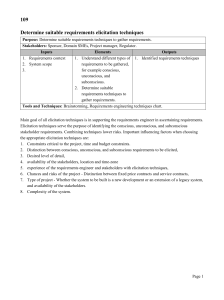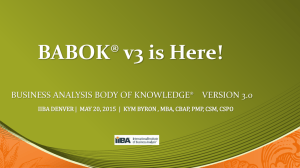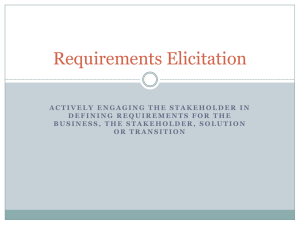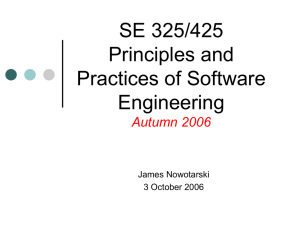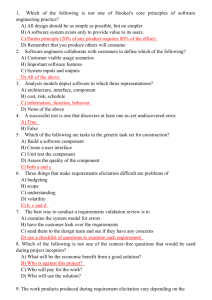Requirements
advertisement
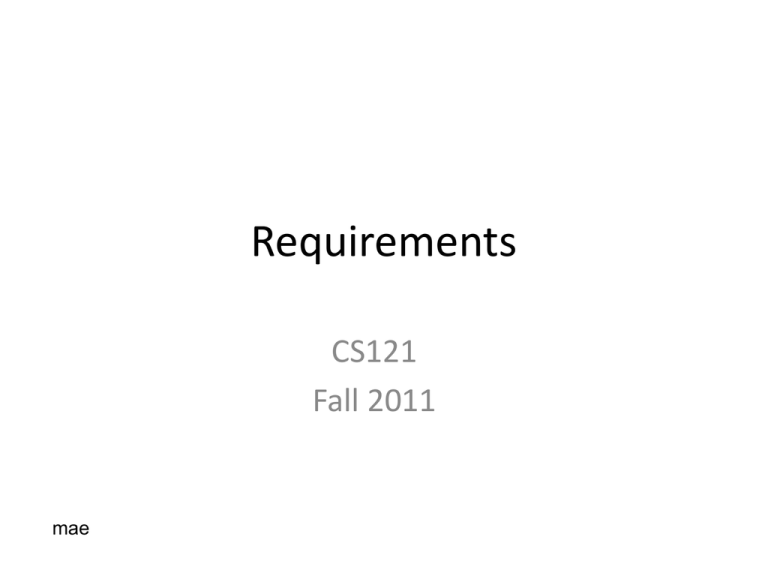
Requirements CS121 Fall 2011 mae Administrivia • • • • Teams chosen, glics assigned, mail lists made Tracs created svns created 2nd floor access in place – 2nd floor needs work.... • elicitation schedule coming... Panic: Due in next 7 days • Bunch of Phase 1 stuff • . Requirements “What does the customer actually wants?” can requirements be created, analyzed, evaluated, etc Types of Requirements: FURPS+ • • • • Functional: features, capabilities Usability: human factors, aesthetics, consistency, documentation Reliability: frequency of failure, recoverability, predictability Performance: response times, throughput, accuracy, availability, resource usage • Supportability: adaptability, maintainability, configurability • +: others Why are requirements so important? • We need to know what we are supposed to build before we can build it. dhu • Failures at this stage are costly. Cost to Fix is introduced when problem is requirements found design construction requirements 1x design 3x 1x construction 5-10x 10x 1x system test 10x 15x 10x post ship 10-100x 25-100x 10-25x Case 1: A friend was on review RED team for a Norwegian air defense contract. The customer generated an ops (operations) concept document that was about 100 pages long from which a flat requirements document containing about 2000 requirements was generated. The problem with this contract was that the 2000 requirements were not definite enough, thus the result was a floating set of slightly different requirements every 6 months or so. The project was a 3 year project in it's 6th year with 100% overrun on a fixed price contract (reason for the red team review). Why are requirements so important? • We need to know what we are supposed to build before we can build it. duh • Failures at this stage are costly. • Failures at this stage are common. Why are requirements so difficult to specify? • Customer’s can’t tell you what they want – they don’t know – they don’t clearly articulate their needs Why are requirements so difficult to specify? • Customer’s can’t tell you what they want Case2: There were two ops concept documents, each about 2-4 pages long, one from developer view and one from a customer view. This resulted in a 50 page top level system requirements document from which about 5 or 6 lower level requirements documents were written e.g., spacecraft requirements document, network requirements document, set-top box requirements document; operations requirements document, air-link requirements document, etc. A document was then written showing the linkage/relations between all the various requirements. Why are requirements so difficult to specify? • Customer’s can’t tell you what they need – they don’t know – they don’t clearly articulate their needs • Customer’s have conflicting needs You must control at least one parameter! Customer: I want to pay $500 for its development Cost Quality Customer: I want the best RPG ever Time Developer: It will be finished when hell freezes over. Why are requirements so difficult to specify? • Customer’s can’t tell you what they need – they don’t know – they don’t clearly articulate their needs • Customer’s have conflicting needs • Customer’s needs change or there understanding of their needs during project life % increase in requirements Growth in requirements Source: Applied Software Measurement, Capers Jones, 1997. Based on 6,700 systems. Why are requirements so difficult to specify? • Customer’s can’t tell you what they need – they don’t know – they don’t clearly articulate their needs • Customer’s have conflicting needs • Customer’s needs change • Technology changes, along with price – Monitors – 10 years ago paid $2k for a 600x800, today $300 for a much better display + can run 2 displays Developing requirements: Best Practices • Still a developing area Developing Requirements • Inception: – define initial concept – identify stakeholders Developing requirements Management … Marketing Users stakeholders all of the above Software Engineer Developing requirements for games Management Marketing … Game Designer Users Software engineers Developing Requirements • Inception: – define initial concept – identify stakeholders – gather background information: competitive analysis, technology review, etc. – identify “perceived requirements“ Developing Requirements • Inception • Elicitation: Ask the customer what they want Requirements Elicitation I want you to build a game ... customer/stakeholder software engineer Requirements Elicitation I want an RPG better than anything seen before! customer/stakeholder software engineer Requirements Elicitation Ok ... off you go! Call me when its done. customer/stakeholder software engineer Requirements • Inception • Elicitation: What do customer say they want? • Analysis: What does the customer really want? Requirements Analysis OK here is my idea for the game. What do you think? customer/stakeholder software engineer The exchange begins... and must continue Requirement Solicitation • Specify what not how – hard to do Having some sort of sorting game with pictures of chemical reactions and physical Requirements Analysis Great! Can I have it next week? customer/stakeholder software engineer Requirements • Inception • Elicitation: What does the customer say they want? • Analysis: What does the customer really want? What can you realistically provide? Do you really understand. Feasibility: Can we meet the constraints? Cost Quality Time Feasibility • Understand the proposed system • Understand the capabilities of your team and tools • Explore gaps in requirements (or risks) Requirements • Inception • Elicitation: What does the customer say they want? • Analysis: What does the customer really want? What can you realistically provide? Software Requirements Specification (SRS) Requirement Quality • Specify what not how – hard to do Having some sort of sorting game with pictures of chemical reactions and physical reactions Chemical reactions: Baking soda/vinegar, baking, cooking, toasting, burning ect Physical reactions: Cutting, ripping, mixing, melting Another idea is a little more complex Having students sort the chemical elements into correct place on the periodic table based are their properties. My idea is that an alien periodic table has been found and the students need to place the alien elements into the correct spot based on the elements and properties. The elements would be very similar to the earth periodic table. Students would need to know about the number of protons neutrons electrons I attached an example of the alien periodic table activity • Unambiguous – English is designed for ambuiguity Waterfall Model with feedback Requirements SRS Design Implementation Test Agile requirements Project inception: move from requirements to goals • Identify high level scope • Key requirements • Initial “goal stack” highest priority, best modeled goals Well modeled means we understand what to do and how long it will take. lowest priority, least modeled goals Agile requirements At the start of each iteration: • Incorporate new goals (often produced by last iteration) • Remove items no longer needed • Reprioritize • Clarify requirements for goals at top of stack • Plan iteration highest priority, best modeled goal Who prioritizes? Customer driven Risk driven lowest priority, least modeled goal Requirement Quality, cont • • • • • Testable Feasible Consistent – analysis critical Prioritized Traceable – number of systems to build a table matching requirements (numbers) to specific code • Agreed upon by customer Next time: elicitation demonstration • Meet the customer • At least 1 team will do an in-class elicitation • other teams will do their elicitation Tuesday evening 5-8. after class (or if need be Wed morning) Prior to Elicitation • Prepare short (2-4 slide) concept presentation • List of “perceived” requirements and questions to clarify them • Open ended questions to better understand needs • You may be doing this on Skype or just the phone, so be prepared to ‘present’ your slides without viewing Elicitation format • Introduce yourselves and provide agenda • Give your (2-4 slide) concept presentation • Start with open-ended information gathering This is where you’ll discover issues you haven’t thought of on your own. Elicitation format • • • • • Introduce yourselves and provide agenda Give your (2-4 slide) concept presentation Start with open-ended information gathering Follow up on new issues raised Discuss “perceived” requirements Based on your background research you should have some reqs in mind before the meeting starts. Elicitation format • • • • • • • Introduce yourselves and provide agenda Give your (2-4 slide) concept presentation Start with open-ended information gathering Follow up on new issues raised Discuss “perceived” requirements Discuss priorities Present a summary of key points and give the teacher an opportunity to confirm/correct • Thank the teacher Elicitation roles • Moderator: Leads the meeting, discussion • Scribe: Takes notes • Others – Distill discussion for final summary – Keep track of points that need clarification – Keep track of pre-determined requirements that need validation – Watch clock, agenda Elicitation Report • • • • • • When, where, and who Summarize discussion New requirements Validation of prior requirements Priority of requirements Any other interesting information Lecture Sample questions • • • • • • • • • Why are requirements so important? Why are they so difficult to specify? What are the various types of requirements? What are the first steps of requirements gathering? What is a customer elicitation? What is involved in requirements analysis? What is an SRS? What constitutes quality in requirements? How are requirements managed in agile processes? Summary • what are requirements • types • difficulties in getting ‘good’ equirements • process of acquiring requirements • cycle of elicitation - evaluate/analysis - refine Assignment for next time • Prep for elicitation – concept presentation – open ended questions – perceived reqs and questions to clarify – roles assigned to team members Scheduling of elicitations • In-class • After-class • email has been sent, waiting for responses from teachers..... The End Most errors found by users in software are the result of A. coding errors B. errors in requirements C. system integration errors D. errors in the design of the solution Answer: B “Software’s Chronic Crisis”
